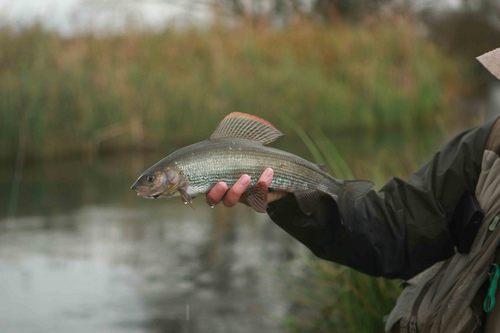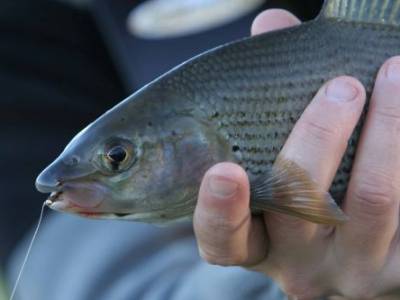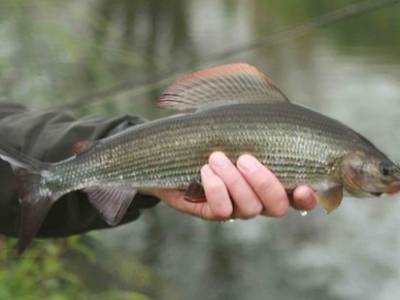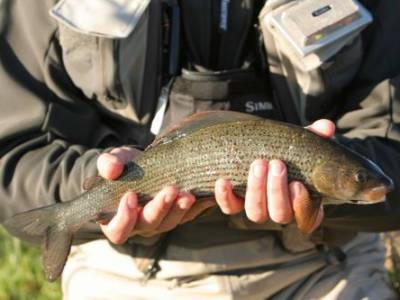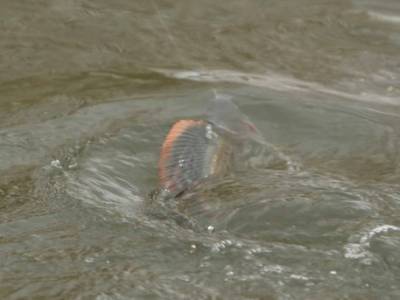A Christmas Grayling
I’m astounded how few river anglers I meet are fully aware of the extra dimension that flowing water gives our flies when fishing for grayling and trout. Moving water can be our ally or our enemy. It takes some thought to truly understand what is going on in that aquatic domain, as movement of a liquid or flow is a very complex phenomena, in fact a science in itself. Pause for a moment and think like a grayling! A basic understanding of hydrology or having some river-craft will give the stream fisherman a far greater success rate.
Take a hatch pool on a Hampshire chalkstream for example. Deep oxygenated water and loved by fish, but the rules here are upstream fishing only. Which way is upstream? Looking into the clear water doesn’t really help as one sees fish facing all directions in the eddies and undercurrents of the pool different directions at different depths too – a really tricky one to fathom. How then do we have any chance of presenting our nymph to look like the real thing in this cauldron of complexity? In other words present the perfect drag free drift?
Before making an upstream cast on any river, look at the water and try to read it. Where is the flotsam flowing? A good indication is bubbles or foam on the surface .Foam is Home they say in the States. Grayling often position themselves just on the edge on this main flow. For example, either in the seam between two slightly different speeds of water, or beneath it in a slight depression on the river bed, from which they rise slightly to eat. We often refer to the latter as a scallop. In the winter, a small scallop of 6 feet diameter can hold perhaps twenty grayling and an angler with good river-craft and stealth should winkle at least half a dozen from the shoal before they cotton on. First find your scallop!
Methodically search the river with carefully placed casts, always bearing in mind the two golden rules and it won’t be too long before you locate your shoal and see the glisten of mirror scales across the rim of your net become a more frequent occurrence.
A drag free drift is undoubtedly the first golden rule river fishing, particularly for grayling. What is drag? Drag is unnatural motion imparted to one’s fly by push or pull on the line and leader by the stream’s current. To present an artificial that is attached to tippet, leader and flyline without even micro drag takes thought and skill, but it can be done. There are many innovative techniques that can help one achieve this.
The foremost technique, and nothing to do with modern business hierarchy, is basic line management. Cast your fly into the current in a direction that allows it to sink and drift without the current pulling or pushing the line in any way. Just like the real thing fish have evolved to intercept items travelling exactly at current speed this speed is a trigger point for the fish to eat. Place an upstream mend in the flyline as the cast is made the reach mend is a great river cast and one I could not do without just move the tip of the rod upstream as the flyline is about to land on the water. This gives us some slack between rod tip and fly, thus allowing the nymph to sink down to the scallop and move through the fish drag free. Our floating flyline doesn’t help us at all as it has a poor drag co-efficient, especially if the current is faster under our rod tip than where we are fishing the fly. If this imparts even the slightest drag on our line and consequently our fly, it will look very unnatural to our quarry and will often spook the whole shoal real olive nymphs can’t do 15 knots across the current! Think about your flyline, its position relative to flow and its effect on the fly. The Americans and the Czechs showed us how to high stick the rod to varying degrees, basically keeping as much of the flyline out of the water as possible great for short range fishing and enhanced with a longer rod. Most accomplished grayling fishermen now use a 10 or even 11 foot rod, this gives longer reach and a greater lever for line control as you salmon anglers have known for years, a longer rod puts a larger mend in a flyline and helps pick up slack more efficiently. Look at 10 footers for a 4 or even 3 weight. The new Hardy Marksman is a jewel. Follow the line with the rod tip to maintain some slack and reach out at end of drift for that extra yard without drag a longer rod gives a longer reach and I have noticed often the longer the drag free drift, the better. In clear water, I’ve watched wary fish follow the nymph some distance before eating or rejecting it.
This brings us to golden rule number two pin pointing the take. The Lady of the stream is a gentle fish often giving us a very subtle nibble. The nymph may be inhaled and ejected with the slightest of movement to the fly and leader. How then do we detect this in such complex flow, whilst fishing a small nymph in tinted water, squinting under the low winter sun.totally drag free of course?
Most British fly fishermen have some distain for bite indicators eavesdropping conversations, I’ve often heard mumbles about float fishing, maggots and roach! However, bite indicators have come a very long way from the American bobber or English float and there is a distinct marriage between these bite indication techniques and drag free drift.
Indicators:
The bung type indicator is attached to the leader at a depth that is suitable for the run one is fishing and the fly or usually flies hang below the indicator. Thus the indicator is a hinge point and below it the flies are held down with added weight. The larger the bung, the more weight can be used. I like a small lead free shot or putty added just above or between the two flies (usually one on a top dropper 15 or so from the point fly). Bung indicators are perhaps most frowned upon as there is maybe less skill involved fishing them one of our unwritten rules. They are also not very sensitive to the more delicate takes and they can actually increase drag on the fly in stronger and complicated currents. However, in certain circumstances and fished properly, they can be deadly; they are very visible in flat winter light or at long distance and the bung is easily adjusted for fishing a river with varying depths without re-rigging. The bung indicator comes into its own fishing faster, deeper runs with heavy flies or shot, where one needs the flies to get down to the fish quickly.
Wool or yarn indicators have their advantages too. In the colder weather grayling are usually in the slower, deeper water in quite tight shoals. The poly yarn indicator is good for fishing moderately heavy nymphs under these conditions. Although there are many on the market, they are easy to make yourself. I find they are also easier to cast than the bung type, especially in wind. I use a poly yarn indicator when fishing long leaders well a long section of tippet between the indicator and the flies to be precise. I usually fish tippet beneath the indicator about 1 times deeper than the depth of water. With long leaders, there’s nothing worse that the indicator getting stuck in the tip ring when coaxing fish to net. These can be fitted to slide down the leader at this point Tie them with poly yarn on the plastic tube used for salmon tube flies, thread onto your leader and peg the tube with a small cone shaped piece of plastic toothpicks are perfect.
The dryfly..In the same way one can fish hopper / dropper or New Zealand style using a dryfly as an indicator. This increases one’s odds above that of the plain indicator because the dryfly / indicator also has a chance of hooking a fish. Rather than use a dropper I usually adopt the NZ approach. A length of tippet is tied with a half blood knot to the bend of the hook of the dry fly and a nymph (or nymphs) are hung below this to match the depth of water again I like to fish slightly over depth. And experiment with which nymph has the weight the point fly or the dropper swap them around you’ll be amazed how much difference this makes in certain flow configurations. It is also surprising how smaller a dry fly one can get away with I really like a small CDC olive pattern with a #18 or #20 tungsten bead head flashback PTN below. The dryfly in conjunction with these micro nymphs works wonderfully well in shallower and slower water, where little weight is needed. There are now several excellent patterns of specialist indicator dryflies that combine visibility with attractability and incorporate buoyant materials such as palmered hackles, deer hair and CDC.
Coloured florescent monofilament Incorporate a few inches (5" to 10") of coloured monofilament into your leader at the required depth. Coloured Stren, Raglon Soft or one of the competition beach casting lines are best. The more opaque the better. This can be greased and fished as a regular indicator or held up above the water by “high sticking" the rod at closer range. Add two coloured sections to allow fishing at different depths and to give contrast in varying light. This method detects the most delicate of takes but takes a little practice. The French International Rivers Team perfected this bite detection technique in conjunction with a fishing method that reduces drag dramatically. The French team use a very long leader made to a specific formula and catapult cast the flies using a long and relatively soft rod. No flyline is off of the reel at all. Therefore, the slim diameter and carefully tapered leader is used as one’s flyline and it’s surprising how far it can be cast with weighted, Czech style nymphs. In the water it produces remarkably little drag due to the smaller diameter and is truly a revelation in nymph fishing enabling the skilled angler to tempt the weariest fish in the most complex of flow situations. This really is the way to fish a hatch or weir pool in winter – I highly suggest you give this method a go. With a little practice it has amazing results. For French style leader formulas see the table in Karel Krivanec’s Czech Nymph book.
The coil or spiral of coloured monofilament- Coloured mono can be coiled as a bite indicator and greased with Red Mucilin. This floats a little higher than the straight mono and consequently will support heavier flies. It is also easier to see and therefore lends itself to fishing slightly deeper and faster water. To coil the mono, wrap it round a dowel or plastic tube and either steam with the kettle or soak in water and vinegar and bring to the boil. This will give the mono memory and it will stay coiled all day.
The Zebra stripped tip to fly line Add a short section (12" or so) of orange or yellow fly line between the end of your fly line and the butt of the leader. Mark zebra stripes on this with a black permanent marker pen. These stripes give the human eye a reference and enable one to see the smallest of movement. Watch for the jag as a fish takes and strike.
With all these indication methods striking is essential for any suspected take. False takes are common as the fly has caught on weed or the bottom. On a good day perhaps one in six takes will be a fish usually less. When a winning drift is located often it will account for several fish so take your time and perhaps let the drift rest between casts or fish.
In trying to lessen the frequency of false takes, I have experimented with tying weedless nymphs with loops of mono and mini weed guards. Especially on the heavier patterns incorporating tungsten beads and the excellent bidoz tungsten shrimp bodies. Some excellent grayling fishermen also tie their flies on mini American jig hooks that incorporate the weighted head on a kink in the hook. Both the jig hook and the Bidoz body present the fly to swim upside down like a bonefish fly, hook point uppermost. These jig nymphs and Bidoz shrimps make the perfect point fly to bounce along the bottom – they are far less likely to snag than the conventional weighted nymph. Food for thought this winter!

